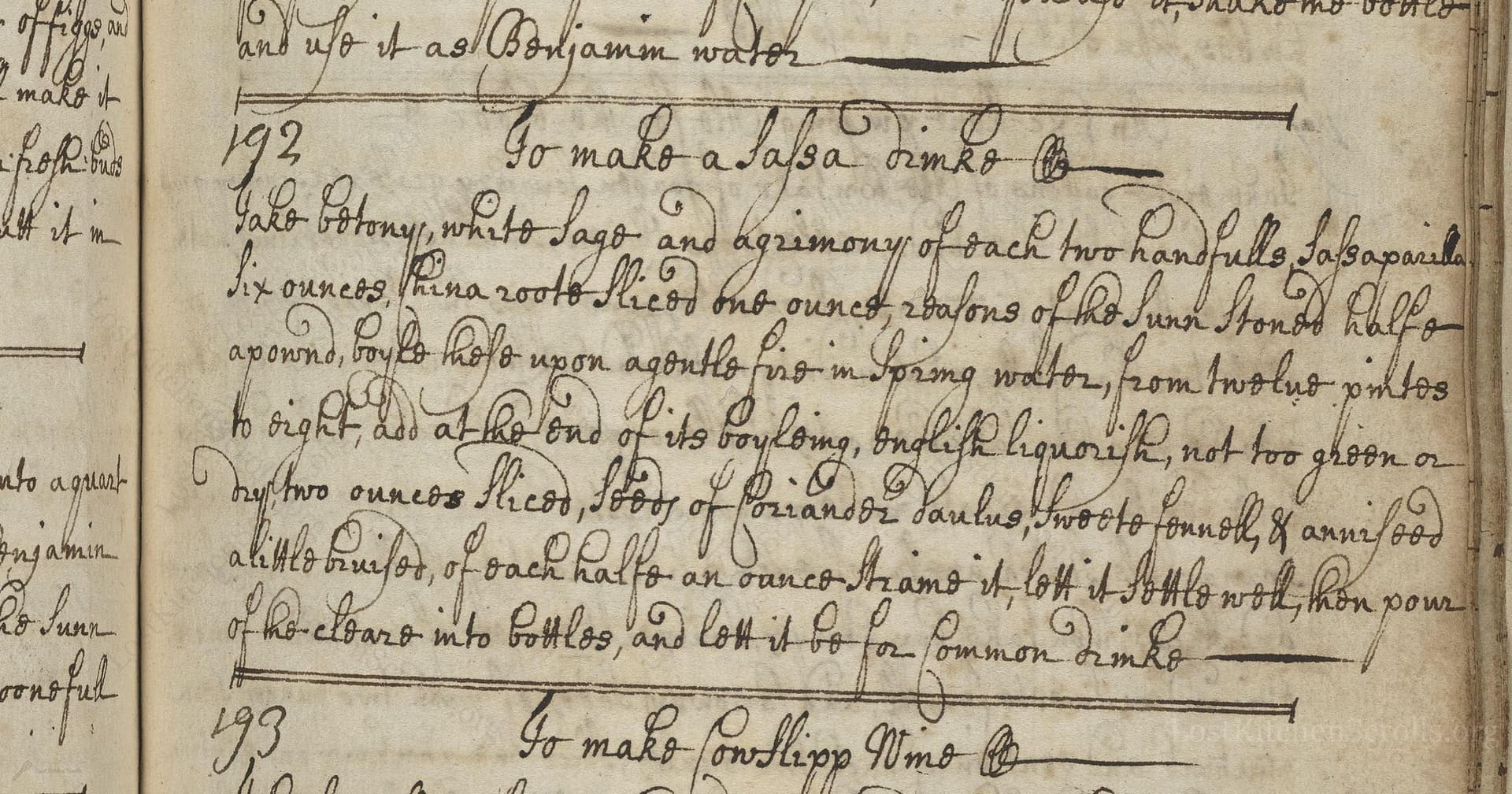To Make A Salsa Drink
From the treasured pages of Receipt book by Beulah Hutson
Written by Beulah Hutson

To Make A Salsa Drink
"Take Botony, white sago and Agremony, of each two handfulls, Sarsaparila six ounces, China roots slicd one ounce, rubarbe a pound, boyle these upon a gentle fire in spring water, from twelve pintos to eight, add at the end of its boyleing, English liquorish, not too green or bigg two ounces slicd, seeds of Coriandor, seeds of fennell, and annis seed a little bruisd, of each halfe an ounce, straine the liquor into bottles, and lett it go for common drinke."
Note on the Original Text
This recipe is expressed in the typical style of late 17th-century English household manuals: approximate measures (by handful, ounce, or pint), minimal instruction, and reliance on the reader's practical knowledge. Contemporary spellings reflect the period—'boyle' (boil), 'pintos' (pints), 'agremony' (agrimony), 'straine' (strain). These informal, direct texts expected the cook to adapt based on available ingredients and experience, often omitting details now seen as necessary. Standardization of spelling and measurement was just beginning, infusing recipes with a sense of both adventure and ambiguity.

Title
Receipt book by Beulah Hutson (1680)
You can also click the book image above to peruse the original tome
Writer
Beulah Hutson
Era
1680
Publisher
Unknown
Background
A delightful journey into 17th-century kitchens, this manuscript stirs together rustic recipes and culinary secrets, inviting readers to savor the ingenious flavors of Beulah Hutson's time.
Kindly made available by
Folger Shakespeare Library
This recipe hails from the household manuscript of Beulah Hutson, circa 1680, a period when medical and culinary boundaries blurred. England’s fascination with botanical remedies flourished, and 'Salsa' drinks were touted as daily tonics thought to cool the blood and purify the body. The ingredients, a reflection of trade networks and colonial interests, marry the local (agrimony, rhubarb) with global newcomers like sarsaparilla and China root. Such concoctions were often part of aristocratic or well-to-do households’ repertoire, bridging health, hospitality, and kitchen experimentation.

Preparation would involve a large copper or earthenware cauldron for slow simmering over an open hearth or gentle coals. Ingredients were measured by the handful or by weight using simple hand-held scales. A mortar and pestle was used to bruise seeds, while a sharp knife or herb cutter prepared roots and rhubarb. Straining was done with linen cloths or fine sieves, and the final brew stored in green glass bottles or stoneware jugs sealed with waxed cloth or cork.
Prep Time
20 mins
Cook Time
1 hr 30 mins
Servings
8
We've done our best to adapt this historical recipe for modern kitchens, but some details may still need refinement. We warmly welcome feedback from fellow cooks and culinary historians — your insights support the entire community!
Ingredients
- White sago: 2.5 oz
- Fresh or dried agrimony: 2 oz
- Borage or assorted soft culinary herbs ('Botony'): 2 oz
- Sarsaparilla root: 6 oz
- China root (or substitute with Chinese yam): 1 oz
- Rhubarb (fresh or dried): 1 lb
- Spring water: 1.6 gallons
- English licorice root (sliced): 2 oz
- Coriander seeds (bruised): 0.5 oz
- Fennel seeds (bruised): 0.5 oz
- Anise seeds (bruised): 0.5 oz
Instructions
- To recreate this 17th-century 'Salsa drink,' gather botanicals: white sago (about 2.5 oz), agrimony (two large handfuls, roughly 2 oz), and borage or other botany herbs (another 2 oz).
- Add 6 oz sarsaparilla root, 1 oz sliced Chinese yam (as a substitute for historical China root), and 1 lb fresh or dried rhubarb (fresh or dried is acceptable).
- Place all ingredients in a large pot with 1.6 gallons of spring or filtered water.
- Simmer gently until reduced to 1 gallon, keeping the heat low to avoid boiling away delicate flavors.
- In the last stage, add 2 oz English licorice root (not overly green or thick, sliced), 0.5 oz each of bruised coriander, fennel, and anise seeds.
- Stir, simmer for a final few minutes, then strain the hot infusion through a clean cloth.
- Bottle the cooled drink and refrigerate.
- Enjoy chilled as a herbal, lightly sweet and aromatic restorative drink.
Estimated Calories
30 per serving
Cooking Estimates
It usually takes around 20 minutes to get your herbs and roots ready, and about 1.5 hours to simmer and reduce the drink. Since this recipe makes about 4 liters, it's enough for 8 servings of 500 ml each. Each serving is low in calories, just about 30 per glass, as most ingredients are herbs and roots.
As noted above, we have made our best effort to translate and adapt this historical recipe for modern kitchens, taking into account ingredients nowadays, cooking techniques, measurements, and so on. However, historical recipes often contain assumptions that require interpretation.
We'd love for anyone to help improve these adaptations. Community contributions are highly welcome. If you have suggestions, corrections, or cooking tips based on your experience with this recipe, please share them below.
Join the Discussion
Rate This Recipe
Dietary Preference
Main Ingredients
Culinary Technique
Occasions

Den Bockfisch In Einer Fleisch Suppen Zu Kochen
This recipe hails from a German manuscript cookbook compiled in 1696, a time whe...

Die Grieß Nudlen Zumachen
This recipe comes from a rather mysterious manuscript cookbook, penned anonymous...

Ein Boudain
This recipe comes from an anonymous German-language manuscript cookbook from 169...

Ein Gesaltzen Citroni
This recipe, dating from 1696, comes from an extensive anonymous German cookbook...
Browse our complete collection of time-honored recipes



